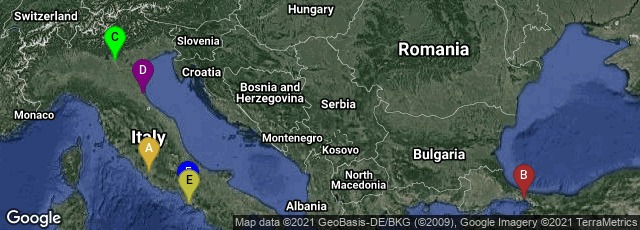
A: Roma, Lazio, Italy, B: İstanbul, Turkey, C: Verona, Veneto, Italy, D: Ravenna, Emilia-Romagna, Italy, E: Napoli, Campania, Italy, F: Capua, Campania, Italy
"Excavations carried out at the beginning of the twentieth century in the Capella Sancta Sanctorum, the only surviving part of the ancient Lateran Palace, discovered among the foundations of the chapel the remains of a room of the earliest Lateran library. On one wall was a fresco of a reader, apparently Augustine, seated at a desk, an open codex before him. Beneath it was a legend referring to the writings of the fathers" ( (Gamble, Books and Readers in the Early Church [1999] 162-63).
The Lombard (Langobard, Longobard) Germanic invasion of Italy in 585, which roughly coincides with the death of Cassiodorus, marked the end of the continuity of Late Latin culture in most of Italy.
According to Bernhard Bischoff,
"we cannot be sure whether remnants of the twenty-eight public libraries which are mentioned in a fourth-century description of the urbs Roma continued to survive. There was certainly a library at the Lateran, and libraries and archives existed in Rome as well as in other cities like Capua, Naples, Ravenna, and Verona. There were also monastic libraries like the one in Eugippius' monastery. Copies of the Code of Justinian produced in Constantinople must have been kept ready for consultation by public administrators in their offices. If the famous Codex Pisanus of the Digest of Justinian now in Florence was not at that time in use in Italy, the papyrus copy once at Ravenna, of which a few folios are preserved at Pommerfelden near Bamberg, certainly was. We know that there still existed examplars corrected by their authors themselves, such as Boethius. There were probably manuscripts in Italy copied by Jerome himself. Marginal notes made by readers or colophons referring to the collation of texts show that many manuscripts belonged to private citizens or to specific libraries. The Codex Mediceus of Virgil was studied by the consul Turcius Rufius Apronianus Asterius (cos. 494); the name of the consul Vettius Agorius Basilius Mavortius (cos. 527) is found in the Paris codex of Prudentius. In many cases, the notes and corrections of readers and grammarians were fortunately preserved for us in later copies. The activities of the families of Symmachus and Nicomachus in the pagan revival at the end of the fourth century century influenced the tradition of the works of Livy. Subscriptions in a Carolingian manuscript now in the Bibliotheca Ambrosiana in Milan, G. 108 inf.s, saec. IX, testify to the existence of a school of doctors in Ravenna where the exemplar originated. Dedications in exemplars now lost were preserved by copies. The dedication page of the Calendar of 354 tells us the name of the bibliophile Valentinus and of the scribe Philocalus, who is well known as the designer of the inscriptions of Pope Damasus. All this evidence shows that most of these now-lost exemplars, whose copies we fortunately possess, were kept in libraries in Rome, Ravenna, and Campania. Some manuscripts came from Constantinople, like the archetype of Priscian and the copy of Solinus, whose scribe was the emperor Theodius II himself. I conclude this brief catalogue by referring to a small book, formerly kept in the treasure of the cathedral of Chartres, which contains the Gospel of St. John. On the basis of a statement made by Jerome, it is plausible that this little book was originally a Christian amulet. I might also mention a fragment of a Hebrew scroll, Greek codices, and the manuscripts in Gothic, all of which, except for the purple Codex Argenteus in Uppsala, ended up as palimpsests.
"The period of book production from the fourth to the sixth centuries was followed by a period of book distribution which lasted from the time of Gregory the Great to the time of Otto III (d.1002) and perhaps beyond. Many of the libraries still in existence as late as 567 were destroyed in the centuries that followed. Books kept in Rome, Campania, Ravenna, and perhaps in other centres which have not yet been identified, circulated as occasion demanded. The widespread circulation of books probably began with Gregory the Great (d.604), who had copies of his own works made for friends in Italy, for Leander bishop of Seville, and for Theodolinda, the Lombard queen who received from him a copy of his Dialogues as well as a Gospel book, of which only the priceless binding remains today, preserved in the cathedral of Monza. . . ." (Bischoff, Manuscripts and Libraries in the Age of Charlemagne [2007] 7-9). (The links are, of course, my additions.)
(This entry was last revised on 03-21-2014.)